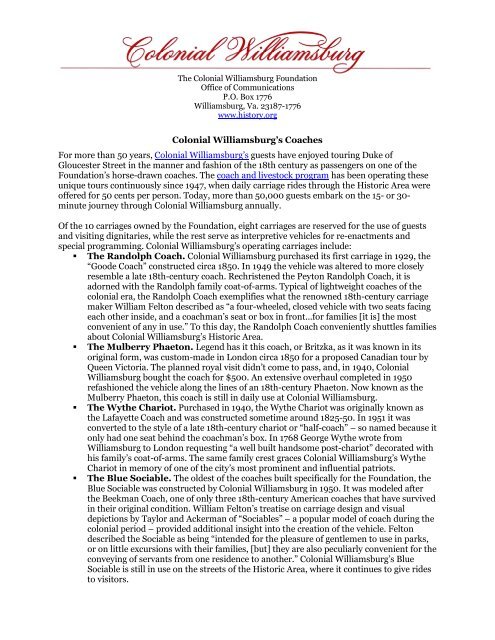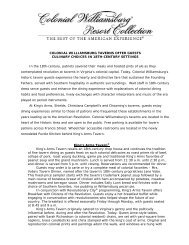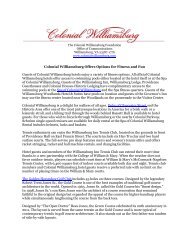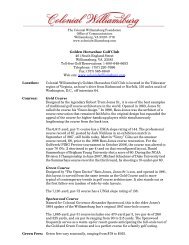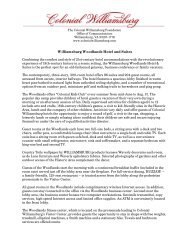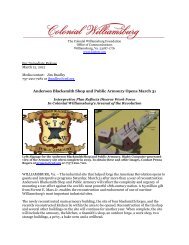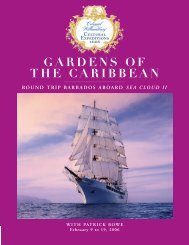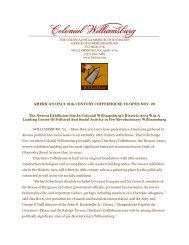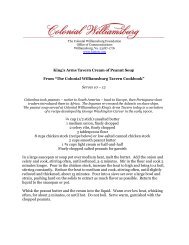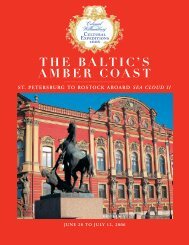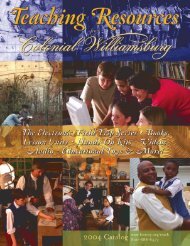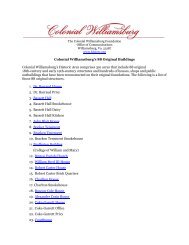Colonial Williamsburg's Coaches For more than 50 years, Colonial ...
Colonial Williamsburg's Coaches For more than 50 years, Colonial ...
Colonial Williamsburg's Coaches For more than 50 years, Colonial ...
Create successful ePaper yourself
Turn your PDF publications into a flip-book with our unique Google optimized e-Paper software.
The <strong>Colonial</strong> Williamsburg Foundation<br />
Office of Communications<br />
P.O. Box 1776<br />
Williamsburg, Va. 23187-1776<br />
www.history.org<br />
<strong>Colonial</strong> Williamsburg’s <strong>Coaches</strong><br />
<strong>For</strong> <strong>more</strong> <strong>than</strong> <strong>50</strong> <strong>years</strong>, <strong>Colonial</strong> Williamsburg’s guests have enjoyed touring Duke of<br />
Gloucester Street in the manner and fashion of the 18th century as passengers on one of the<br />
Foundation’s horse-drawn coaches. The coach and livestock program has been operating these<br />
unique tours continuously since 1947, when daily carriage rides through the Historic Area were<br />
offered for <strong>50</strong> cents per person. Today, <strong>more</strong> <strong>than</strong> <strong>50</strong>,000 guests embark on the 15- or 30-<br />
minute journey through <strong>Colonial</strong> Williamsburg annually.<br />
Of the 10 carriages owned by the Foundation, eight carriages are reserved for the use of guests<br />
and visiting dignitaries, while the rest serve as interpretive vehicles for re-enactments and<br />
special programming. <strong>Colonial</strong> Williamsburg’s operating carriages include:<br />
The Randolph Coach. <strong>Colonial</strong> Williamsburg purchased its first carriage in 1929, the<br />
“Goode Coach” constructed circa 18<strong>50</strong>. In 1949 the vehicle was altered to <strong>more</strong> closely<br />
resemble a late 18th-century coach. Rechristened the Peyton Randolph Coach, it is<br />
adorned with the Randolph family coat-of-arms. Typical of lightweight coaches of the<br />
colonial era, the Randolph Coach exemplifies what the renowned 18th-century carriage<br />
maker William Felton described as “a four-wheeled, closed vehicle with two seats facing<br />
each other inside, and a coachman’s seat or box in front...for families [it is] the most<br />
convenient of any in use.” To this day, the Randolph Coach conveniently shuttles families<br />
about <strong>Colonial</strong> Williamsburg’s Historic Area.<br />
The Mulberry Phaeton. Legend has it this coach, or Britzka, as it was known in its<br />
original form, was custom-made in London circa 18<strong>50</strong> for a proposed Canadian tour by<br />
Queen Victoria. The planned royal visit didn’t come to pass, and, in 1940, <strong>Colonial</strong><br />
Williamsburg bought the coach for $<strong>50</strong>0. An extensive overhaul completed in 19<strong>50</strong><br />
refashioned the vehicle along the lines of an 18th-century Phaeton. Now known as the<br />
Mulberry Phaeton, this coach is still in daily use at <strong>Colonial</strong> Williamsburg.<br />
The Wythe Chariot. Purchased in 1940, the Wythe Chariot was originally known as<br />
the Lafayette Coach and was constructed sometime around 1825-<strong>50</strong>. In 1951 it was<br />
converted to the style of a late 18th-century chariot or “half-coach” – so named because it<br />
only had one seat behind the coachman’s box. In 1768 George Wythe wrote from<br />
Williamsburg to London requesting “a well built handsome post-chariot” decorated with<br />
his family’s coat-of-arms. The same family crest graces <strong>Colonial</strong> Williamsburg’s Wythe<br />
Chariot in memory of one of the city’s most prominent and influential patriots.<br />
The Blue Sociable. The oldest of the coaches built specifically for the Foundation, the<br />
Blue Sociable was constructed by <strong>Colonial</strong> Williamsburg in 19<strong>50</strong>. It was modeled after<br />
the Beekman Coach, one of only three 18th-century American coaches that have survived<br />
in their original condition. William Felton’s treatise on carriage design and visual<br />
depictions by Taylor and Ackerman of “Sociables” – a popular model of coach during the<br />
colonial period – provided additional insight into the creation of the vehicle. Felton<br />
described the Sociable as being “intended for the pleasure of gentlemen to use in parks,<br />
or on little excursions with their families, [but] they are also peculiarly convenient for the<br />
conveying of servants from one residence to another.” <strong>Colonial</strong> Williamsburg’s Blue<br />
Sociable is still in use on the streets of the Historic Area, where it continues to give rides<br />
to visitors.
<strong>Colonial</strong> Williamsburg <strong>Coaches</strong> – PAGE 2<br />
<br />
<br />
<br />
<br />
The Landau. The Foundation’s VIP coach, the Landau, was constructed by <strong>Colonial</strong><br />
Williamsburg personnel with the assistance of carriage authority Paul Downing in 1960.<br />
Named for the German town from which they originated, Landau carriages were in use<br />
in England by the mid-18th century. Felton described them as “built in the manner of a<br />
coach but with the upper part of the body to open at pleasure.” There was at least one<br />
Landau in colonial Virginia; the 1775-76 inventory of Philip Ludwell Lee of Stratford in<br />
West<strong>more</strong>land County lists such a vehicle. <strong>For</strong> this reason, <strong>Colonial</strong> Williamsburg’s<br />
Landau is emblazoned with the Lee family coat-of-arms, whose Latin motto reads, “Ne<br />
incautus future” (“Not heedless of the future”). It is used primarily for special events and<br />
visiting heads-of-state. Notable passengers have included Richard Nixon, King Hussein<br />
of Jordan, Emperor Hirohito and Empress Nagako of Japan, Lady Bird Johnson, Ronald<br />
Reagan, King Harald and Queen Sonja of Norway, United Nations Secretary General<br />
Koffi Annan and Queen Elizabeth II of England, as well as past prime ministers of<br />
Greece, Turkey, Malaysia, India, Taiwan, Denmark, Italy, Pakistan, Tunisia, Ireland,<br />
Canada and Japan.<br />
The Robert Carter Coach. In 2001 work began on <strong>Colonial</strong> Williamsburg’s first new<br />
coach in four decades, made possible through the generosity of Maureen and Jim<br />
Gorman. Completed the following year by Florian Staudner of Vienna, Austria, it is based<br />
on an 18th-century English traveling coach in the ownership of Andre Becker of<br />
Coisigners, France. The coach takes its name from an 18th-century member of<br />
Williamsburg’s gentry, who in 1773 ordered “a strong, fashionable coach without a box,<br />
no guilding thereon, but neatly painted and varnished, the body to be lined with blue<br />
leather.” Carter’s coach was built in London by Joseph Jacobs Jr. for a then-exorbitant<br />
£119. In his honor, today’s Robert Carter Coach bears his family’s coat-of-arms, which<br />
includes the Latin motto, “Purus Sceleris” (“Pure in regards to wickedness or crime”).<br />
The Royal Governor’s Coach. Upon completion of the Robert Carter Coach,<br />
Staudner set to work on the newest addition to <strong>Colonial</strong> Williamsburg’s carriage fleet,<br />
once again through the generosity of Mr. and Mrs. Gorman. Completed in 2005, it is an<br />
exact replica of an 18th-century coach in the keeping of the Museum of the Palazzo<br />
Farnese in Piacenza, Italy. Unique among the Foundation’s carriages, this luxurious<br />
enclosed town coach would have been a mark of wealth and prestige in colonial America.<br />
Just such a vehicle was built for Williamsburg’s last royal governor, Lord Dun<strong>more</strong>, by<br />
Elkanah Deane, who in 1773 wrote, “I made, in the city of New York, for his Excellency<br />
the Right Honorable Earl of Dun<strong>more</strong>, a coach, phaeton, and a chaise, which may now be<br />
seen by any gentleman that has an inclination.” Today, Lord Dun<strong>more</strong>’s town coach can<br />
once again be seen on the streets of Virginia’s colonial capital by any visitors with an<br />
inclination.<br />
The Stage Wagon. The Stage Wagon is a primitive type of public traveling carriage,<br />
used both in England and America, during the 18th and early 19th centuries. The earliest<br />
forms were nothing <strong>more</strong> <strong>than</strong> ordinary covered wagons with several transverse benches<br />
inside. In America, a gradual improvement took place in the construction of the Stage<br />
Wagon during the last third of the 18th century. In 1964 <strong>Colonial</strong> Williamsburg had a<br />
Stage Wagon built modeled on the types used in the third quarter of the 18th century.<br />
The body is hung on thorough braces and the body has a permanent standing top,<br />
supported by eight pillars, leaving the sides open, with roll down curtains that could be<br />
let down in inclement weather. Passengers sit on transverse benches, with the driver<br />
often sharing his seat with one or two passengers. A costumed Stage Wagon driver<br />
guides the brightly painted yellow vehicle, which has space for nine passengers.<br />
<strong>Colonial</strong> Williamsburg’s coach and livestock program is dedicated to furthering the authenticity<br />
of the restored 18th-century capital by ensuring that the vehicles and animals present in the<br />
Historic Area reflect as accurately as possible those that would have been seen on the streets of
<strong>Colonial</strong> Williamsburg <strong>Coaches</strong> – PAGE 3<br />
Williamsburg during the colonial era. The Foundation’s restored and original carriages adhere<br />
to modern standards of safety and comfort while faithfully embodying the designs and materials<br />
of genuine 18th-century coachmakers.<br />
— CWF —<br />
Media contacts:<br />
Jim Bradley<br />
jbradley@cwf.org<br />
Penna Rogers<br />
progers@cwf.org<br />
(757) 220-7286<br />
01/12


